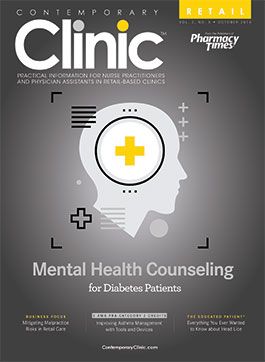Collaborative Care for Diabetic Neuropathy
It is widely accepted that diabetes is a chronic condition characterized by hyperglycemia and high blood sugar, with multiple comorbities.
It is widely accepted that diabetes is a chronic condition characterized by hyperglycemia and high blood sugar, with multiple comorbities.1It is interesting to note that 350 million individuals have diabetes, and these estimates are projected to continue increasing through the year 2030.2Diabetes is a common condition seen in primary care, and peripheral neuropathy is a significant complication associated with it.
Autonomic neuropathy, the type of neuropathy associated with diabetic neuropathy, is one of the least recognized, understood, and validated complications of diabetes. Nevertheless, it is one of the most common complications of both type 1 and type 2 diabetes.1This alone can have serious negative effects on the quality of life of patients. However, there is also significant mortality associated with poor glycemic control of diabetic neuropathy. Peripheral neuropathy usually presents as a loss of sensation that can lead to ulcers and, ultimately, amputation.1The challenge is that it can also be asymptomatic for many patients. Therefore, it is important to consider the facts of diabetes management through a specific case.
Case Study
A 68-year-old man presented to a convenient care setting with a chief complaint of numbness and tingling in both feet. The patient had a history of diabetes with comorbidities of coronary heart disease, hyperlipidemia, and hypertension. Metabolic syndrome was confirmed.
The patient complained of paresthesias, with tingling and numbing bilaterally in both feet, as well as pain in his toes, which he scored as 5 out of 10 for severity. He was taking 500 mg of metformin twice daily, along with lisinopril 20 mg and simvastatin 10 mg, but was unsure about when to take his medications or what they were treating. He confirmed taking herbal supplements and fish oil.
Approximately 3 months ago, the patient noticed some burning and tingling in his feet. He also discussed how his walking had become more difficult with time. He denied experiencing chest pain and shortness of breath. In a review of systems, the patient stated that he had no fever or chills, cough, bloody stools, or blood in urine when he was seen in the office, and he reported that he had gained 10 pounds over the past 3 months. The patient had recently gotten the influenza immunization, as well, but he was up-to-date on all immunizations.
The patient’s physical exam was completely unremarkable. A foot exam revealed a normal pulse and no edema. Decreased sensation was noted bilaterally with microfilament exam, but there were no abnormal cuts or bruises on feet. The patient had a blood glucose of 146 mg/dL, and his hemoglobin A1C was 9.7% (normal range is 4.0%-6.0%), an increase of 1 point from his previous reading a week ago. In reviewing the patient’s blood glucose readings over the past few months, his sugars were noted to be between 200 and 250 mg/dL. Postprandial glucose readings were all above 200.
Discussion Question:What is the differential diagnosis?
Answer:In this case, it could include:
- Myocardial infarction
- Neuropathic arrhythmias (eg, Wolff-Parkinson—White syndrome, sick sinus syndrome)
- Volume depletion
- Diabetic neuropathy
Because of the convenience of the pharmacy collaborative, the patient was immediately referred for medication management with the pharmacist. Multiprofessional collaboration was the focus of this patient’s care. He was started on glipizide 2.5 mg twice daily, taken with breakfast and the evening meal. Metformin was increased to 1000 mg twice a day.
Discussion Question:What type of pain relief would you recommend for this patient?
Answer:In many cases, improved glycemic control will help with the sensation of pain and tingling. Exercise is often helpful, as well. If medication is used, neurontin, as opposed to a narcotic, is a first-line treatment.3For most patients, it is important to focus care on managing both the fasting and postprandial glucose readings through medication and diet treatment plans.
In this case, the patient’s referral to the pharmacist helped clarify cost-effective medication choices and the best times of day to take his medication. Combination medications were also explored. The patient affirmed that the pharmacist counseling helped with adherence during this treatment period.
The patient continued his glucose monitoring and was asked to fax in his blood glucose levels every 2 weeks for the next 2 months. He was encouraged to restart his former exercise regimen, walking 30 minutes daily, 5 days per week. Follow-up phone calls were established to review the patient’s overall care. A diabetes education referral was given by the pharmacist, as well. A podiatrist care referral was made to avoid complications, specifically because diabetic neuropathy can lead to amputations if it is not closely monitored.4
Within a few weeks, the patient’s blood glucose returned to near normal levels of 150 to 170 mg/dL. He reported no hypoglycemic events. The patient was focusing on glycemic goals, and he followed the diabetic medications that were tightened to include glipizide and the increased metformin dosage. He returned in 2 months with decreased pain sensation and declining use of neurontin or any other medication for diabetic neuropathy. In cases such as this, it is important to follow the patient closely for signs of complications. Because of his increased activity, he had also lost 5 pounds by his next visit.
Conclusion
This case’s success is a clear demonstration of the value added by a collaborative practice between providers at the convenient care setting to collectively manage chronic disease indicators.
References
- American Diabetes Association. Standards of medical care in diabetes-2016: summary of revisions.Diabetes Care.2016;39(suppl 1):S4-S5. doi: 10.2337/dc16-S003.
- Wild S, Roglic G, Green A, Sicree R, King H. Global prevalence of diabetes: estimates for the year 2000 and projections for 2030.Diabetes Care. 2004;27(5):1047-1053.
- Lindsay TJ, Rodgers BC, Savath V, Hettinger K. Treating diabetic peripheral neuropathic pain.Am Fam Physician.2010;82(2):151-158.
- Zucchi P, Ferrari P, Spina ML. Diabetic foot: from diagnosis to therapy [in Italian].G Ital Nefrol.2005;22(suppl 31): S20-S22.

